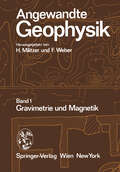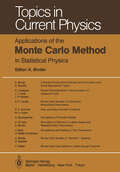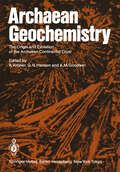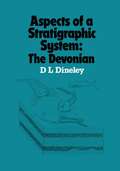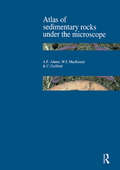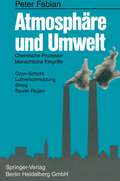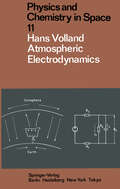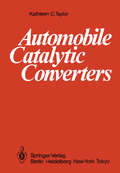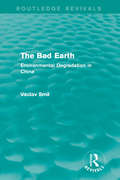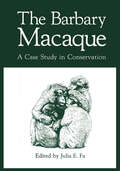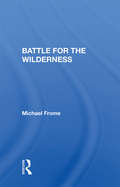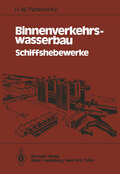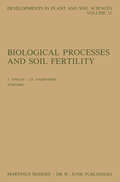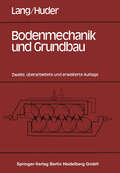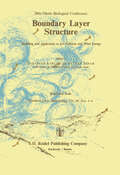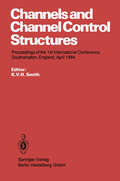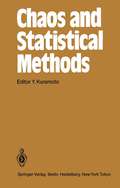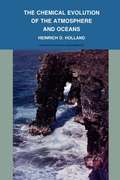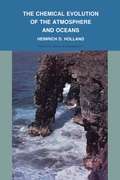- Table View
- List View
Applications of the Monte Carlo Method in Statistical Physics (Topics in Current Physics #36)
by A. Baumgärtner K. Binder J. P. Hansen M. H. Kalos K. Kehr D. P. Landau D. Levesque H. Müller-Krumbhaar C. Rebbi Y. Saito K. Schmidt D. Stauffer J. J. WeisMonte Carlo computer simulations are now a standard tool in scientific fields such as condensed-matter physics, including surface-physics and applied-physics problems (metallurgy, diffusion, and segregation, etc. ), chemical physics, including studies of solutions, chemical reactions, polymer statistics, etc. , and field theory. With the increasing ability of this method to deal with quantum-mechanical problems such as quantum spin systems or many-fermion problems, it will become useful for other questions in the fields of elementary-particle and nuclear physics as well. The large number of recent publications dealing either with applications or further development of some aspects of this method is a clear indication that the scientific community has realized the power and versatility of Monte Carlo simula tions, as well as of related simulation techniques such as "molecular dynamics" and "Langevin dynamics," which are only briefly mentioned in the present book. With the increasing availability of recent very-high-speed general-purpose computers, many problems become tractable which have so far escaped satisfactory treatment due to prac tical limitations (too small systems had to be chosen, or too short averaging times had to be used). While this approach is admittedly rather expensive, two cheaper alternatives have become available, too: (i) array or vector processors specifical ly suited for wide classes of simulation purposes; (ii) special purpose processors, which are built for a more specific class of problems or, in the extreme case, for the simulation of one single model system.
Applied High-Resolution Geophysical Methods: Offshore Geoengineering Hazards
by P.K. TrabantThe discipline encompassing the use of high-resolution geophysics for obtaining geoengineering survey data has evolved rapidly over the past decades to become an interdisciplinary subject encompassing the fields of Geophysics, engineering, geology, marine geology, oceanography, and civil engineering. While high-resolution geophysical surveys are routinely performed offshore today, this has been so only since the late 1960s. High-resolution geophysical methods are employed in the offshore environment to obtain a comprehensive picture of the sea-floor mor phology and underlying shallow stratigraphy. The purpose of the survey methods is to assist in the design and installation of bottom-supported structures such as drilling and production platforms and pipelines. Drilling structures and pipelines of steel and/or concrete have become behemoths with respect to their size and the complexity of their design in order to withstand, for periods of up to twenty-five years, an extremely harsh environment, including storm waves, strong currents, unstable sea floor conditions, and great water depths. It is therefore of paramount importance that the geometry and physical properties of the sea floor be well understood in order to provide an adequate foundation for the design lives of such structures. On land, engineering foundation data usually may be obtained by visual field inspection and shallow borehole information, but offshore the presence of the water column places certain constraints on geoengineering investigations. High-resolution geophysical methods employed in the acquisition of geoengineering data offshore are defined as the use of seismic sources and receivers that operate at acoustic frequencies greater than 100 Hz.
Archaean Geochemistry: The Origin and Evolution of the Archaean Continental Crust
by A. Kröner, G. N. Hanson and A. M. GoodwinArchaean Geochemistry 1972 - 1984 The realisation that the continental crust contains well-preserved relics which date as far back as 4/5 of the Earth's age has given a great impetus to the study of early Precambrian terrains. As late as the mid-sixties the Archaean still constituted the 'terra-in cognita' of earth science. High metamorphic grades, poor out crop, and not least a widely assumed obliteration of early crustal records by convective recycling and thermal reworking had com bined to discourage research in this field. Many excellent local studies existed, notably around gold mining centres, but remained unrelated to a broader regional and theoretical understanding. This situation has changed as the consequence of two inter-related factors: (1) advances in isotopic methods and their application to Precambrian rocks, and (2) the recognition that some of the oldest terrains have retained a wealth of primary igneous and sedi mentary textures and even geochemical characteristics.
Atlas of Sedimentary Rocks Under the Microscope
by A. E. Adams W. S. Mackenzie C. GuilfordProvides a very clear guide to sedimentary rock types as seen under the microscope supported by practical aspects of slide preparation.
Atlas of Sedimentary Rocks Under the Microscope
by A. E. Adams W. S. Mackenzie C. GuilfordProvides a very clear guide to sedimentary rock types as seen under the microscope supported by practical aspects of slide preparation.
Atmosphäre und Umwelt: Chemische Prozesse, Menschliche Eingriffe. Ozon-Schicht, Luftverschmutzung, Smog, Saurer Regen
by Peter FabianAtmospheric Electrodynamics (Physics and Chemistry in Space #11)
by H. VollandThis book resulted from lectures which I gave at the Universities of Kyoto, Cologne, and Bonn. Its objective is to summarize in a unifying way two other wise rather separately treated subjects of atmospheric electrodynamics: elec tric fields of atmospheric origin, in particular thunderstorm phenomena and related problems on the one hand, and magnetic fields, in particular those which are associated with electric currents of upper atmospheric origin, on the other. Geoelectricity and geomagnetism were not always considered as be longing to quite different fields of geophysics. On the contrary, they were re cognized by the physicists of the 19th and the beginning of the 20th century as two manifestations of one and the same physical phenomenon, which we pre sently refer to as electromagnetic fields. This can still be visualized from the choice of names of scientific journals. For instance, there still exists the Japanese Journal of Geomagnetism and Geoelectricity, and the former name of the present American Journal of Geophysical Research was Terrestrial Magnetism and Atmospheric Electricity. Whereas geomagnetism became the root of modern magnetospheric phys ics culminating in the space age exploration of the earth's environment, geo electricity evolved as a step-child of meteorology. The reason for this is clear. The atmospheric electric field observed on the ground reflects merely the local weather with all its frustrating unpredictability. The variable part of the geomagnetic field, however, is a useful indicator of ionospheric and magneto spheric electric current systems.
Automobile Catalytic Converters
by Kathleen C. TaylorThe use of catalytic converters for the purification of automotive exhaust gases is a relatively new technology which was brought into existence by social pressures for the preservation of acceptable environmental conditions. The majority of catalytic practitioners have been able to watch the growth of this technology from its inception to its current state of sophistication. Automotive catalytic converter technology is now in a mature state, and this chapter from Vol. 5 Catalysis: Science and Technology by Dr. K. C. Taylor provides a review which covers both the process chemistry and the most important converter design factors. Contents 1. Introduction. . . . . . . . . . . . . . 2. Emission Regulations in the United States. 3. Exhaust Emission Characteristics. . 3 4. 1981 Emission Control Technology. 5 A. Converters. . . 5 B. Control System. 7 8 ~. Catalyst Screening . 6. Laboratory Testing. .10 7. The Chemical Reactions 13 8. Composition of Three-Way Catalysts. 16 A. Rhodium 17 21 B. Platinum. C. Palladium 22 D. Iridium . 22 23 E. Ruthenium and Nickel. F. Cerium Oxide ..... 23 G. Search for Alternatives to Nohle Metals 24 9. Catalyst Supports . 25 A. Pellets .... 26 B. Monoliths . . 26 10. The Transient Behavior of Three-Way Catalysts 27 II. Deterioration of Three-Way Catalysts. 35 A. Thermal Effects. . . . 35 B. Phosphorus Poisoning. . . 37 C. Lead Poisoning. . . . . . · 38 D. Catalyst Poisoning by Sulfur · 40 12. The 0.4 NO,; Research Objective. · 41 13. Control of Diesel Particulate Emissions.
The Bad Earth: Environmental Degradation in China (Routledge Revivals)
by Vaclav SmilAs China strives to significantly increase its economic output, the nation faces an acute deterioration of the physical resources from which this prodigious growth springs. Major problems include water shortages, the pollution of water, high levels of carcinogens in the air, accelerating erosion, and industrial pollution. Originally published in 1984, Vaclav Smil documents and evaluates China’s environmental crisis. This title will be of particular interest for students of Environmental Studies and Development Studies.
The Bad Earth: Environmental Degradation in China (Routledge Revivals)
by Vaclav SmilAs China strives to significantly increase its economic output, the nation faces an acute deterioration of the physical resources from which this prodigious growth springs. Major problems include water shortages, the pollution of water, high levels of carcinogens in the air, accelerating erosion, and industrial pollution. Originally published in 1984, Vaclav Smil documents and evaluates China’s environmental crisis. This title will be of particular interest for students of Environmental Studies and Development Studies.
The Barbary Macaque: A Case Study in Conservation (Contributions To Primatology Ser. #Vol. 23)
by John E. FaThe Barbary macaque (all too often mistakenly called an ape) was first brought to the attention of the Conservation Working Party of the Primate Society of Great Britain late 1979 when John Fa reported that 'surplus' animals were being sent from Gibraltar to dubious locations, such as an Italian safari park. Since there had been no scientific input into the Army's management of the monkey colony on Gibraltar, and there was concern about inbreeding, nutrition and health - about the long-term viability of the colony, it was felt that the Society could help. The Gibraltar Scientific Authority and the Army were very receptive to our offer and ideas, and this topic occupied successive chairmen over the last few years - Robin Dunbar and Richard Wrangham, myself and now Miranda Stevenson - with constant prompting and help from John Fa. Considerations soon extended to the status of the species as a whole, so that there have been three main aspects:- (1) the improved health of a larger self-sustaining population on Gibraltar, (2) the status and behavioural biology of natural populations in North Africa (Morocco and Algeria), and (3) the breeding achievements in European parks and zoos, and their potential for reintroduction to suitable areas in North Africa, along with other possibilities. Robin Dunbar organized the compilation of recommendations for managing the Gibraltar colony with regard to numbers, age-sex struc ture and behavioural relationships, with some observations on diet to avoid obesity and infertility.
Battle For The Wilderness
by Michael FromeThis book focuses on the principles of wilderness, exploring the actual and potential values of wilderness, its ecology, economics, the effect of human impact, and mechanisms to protect small, relatively untouched tracts in or near urban areas in the United States.
Battle For The Wilderness
by Michael FromeThis book focuses on the principles of wilderness, exploring the actual and potential values of wilderness, its ecology, economics, the effect of human impact, and mechanisms to protect small, relatively untouched tracts in or near urban areas in the United States.
Binnenverkehrswasserbau: Schiffshebewerke
by H.W. PartensckyAnfang der zwanziger Jahre, nach Ende des 1. Weltkrieges, wurde in fast allen europäischen Ländern mit dem Ausbau der vorhandenen Bin nenwasserstraßen begonnen. Diese Entwicklung wurde nach 1950 in ver stärktem Maße fortgesetzt und dauert bis zum heutigen Tage an. Damit gewinnt das europäische Binnenwasserstraßennetz als Verbindung der Seehäfen mit den Umschlags plätzen des Binnenlandes und als Verkehrs weg für den zwischenstaatlichen Gütertransport in zunehmendem Maße an Bedeutung. Bei der Planung neuer Wasserstraßen und beim Entwurf der als Abstiegs bauwerke dienenden Schleusen und Hebewerke sind im Hinblick auf die Sicherheit des Schiffsverkehrs bestimmte Grenzwerte einzuhalten und Bemessungskriterien anzuwenden, die sich zum Teil aus theoretischen Uberlegungen, aber auch aus praktischen Erfahrungen an bestehenden Anlagen ergeben. Diese müssen vom planenden Ingenieur beim Entwurf eines neuen Schiffahrtskanals und seiner Abstiegsbauwerke beachtet werden. Gleichzeitig werden bei ihrer Einhaltung der erreichbaren Lei stungsfähigkeit der Wasserstraße gewisse Grenzen gesetzt. In der Fachliteratur der zwanziger Jahre wurden die derzeit gültigen Erkenntnisse für den Bau von Schiffahrtskanälen, Schleusen und Hebe werken in dem vom Springer-Verlag im Jahre 1921 herausgegebenen Buch von F. ENGELHARD "Kanal- und Schleusenbau" und dem im gleichen Ver lag erschienenen klassischen Werk von o. FRANZIUS "Verkehrswasserbau" dargelegt. In den folgenden Büchern von H. DEHNERT über "Schleusen und Hebewer ke" (Springer-Verlag, 1954) und H. PRESS über "Binnenwasserstraßen und Binnenhäfen" (Verlag von Wilh. Ernst & Sohn, 1956) wurde der wei teren Entwicklung bis Mitte der fünfziger Jahre Rechnung getragen.
Biological Processes and Soil Fertility (Developments in Plant and Soil Sciences #11)
by J. Tinsley J. F. DarbyshireThe success of shifting cultivation systems developed by subsistence farmers testifies to the resilience of the "natural" soil-plant ecosystems to recover from the offtake of nutrients in crops and loss of soil struc ture. By contrast, the development of intensive cropping systems requires large inputs especially of nitrogen, together with phosphorus, sulphur and other essential elements in order to maintain the nutrient levels needed for abundant crop yields. As Dr. Cooke ably pointed out in his introductory lecture, the dis coveries and experiments of the 19th century encouraged farmers in temperate zones to rely greatly on chemical fertilizers supplements. However, the work of Charles Da{win on soil mixing by earthworms and the discovery by Hellriegel and Wilfarth in 1886 that the nodules on legume roots contain colonies of symbiotic bacteria able to "capture" atmospheric nitrogen molecules to the benefit of the host plant heralded a growing realization of the importance of soil biota in fertility studies. Biological fixation of nitrogen has been the theme of many meetings and publi~ations hitherto but at this Conference, convened on the delightful campus of Reading University, attention was mainly focussed on other biological processes in soil fertility. These Proceedings record the dominant themes and include six keynote addresses delivered at plenary sessions and seven introductory lectures to paper reading sessions by invited individuals plus 22 of the proferred papers, in six sections as tabled in the contents list.
Bodenmechanik und Grundbau: Das Verhalten von Böden und die wichtigsten grundbaulichen Konzepte
by H. - Lang J. HuderBoundary Layer Structure: Modeling and Application to Air Pollution and Wind Energy
by Hadassah Kaplan Nathan DinarIn this volume, we present the lectures given during the 1984 OHOLO Conference, held in Zichron Yaacov, Israel. The Conference was organized by the Israel Institute for Biological Research, Department of Mathematics, which is involved in Environmental Risk Evaluation, and in Projects Estimating the Potential of Wind Energy. The lectures cover a broad spectrum of mathematical models, ranging from those that deal with the solution of atmospheric conservation equations, and to those models that yield empirical estimates based on real time measure ments and thus are unique to the locale where measured. The goal of the Conference was to allow scientists from various countries to meet and discuss topics of mutual interest, including the following: 1. Structure of the boundary layer - primarily models dealing in the understanding of the various processes of atmospheric energy transfer, and their influence on the size and composition of the boundary 1 ayer. 2. Advanced mathematical techniques for describing flow and diffusion - lectures on approximations and techniques for solving the diffu sion and transport equations. 3. Flow over complex terrain - research into various aspects of the problem - mathematical models, physical models, experimental results. 4. Models of pollution transport and deposition.
Buildings and Society: Essays on the Social Development of the Built Environment
by Anthony D. KingFirst Published in 1984. Routledge is an imprint of Taylor & Francis, an informa company.
Buildings and Society: Essays on the Social Development of the Built Environment
by Anthony D. KingFirst Published in 1984. Routledge is an imprint of Taylor & Francis, an informa company.
Channels and Channel Control Structures: Proceedings of the 1st International Conference on Hydraulic Design in Water Resources Engineering: Channels and Channel Control Structures, University of Southampton, April 1984
by K. V. H. SmithThe development of water resources has proceeded at an amazing speed around the world in the last few decades. The hydraulic engineer has played his part: in constructing much larger artificial channels than ever before, larger and more sophisticated control structures, and systems of irrigation, drainage and water supply channels in which the flow by its nature is complex and unsteady requiring computer-based techniques at both the design and operation stage. It seemed appropriate to look briefly at some of the developments in hydraulic design resulting from this situation. Hence the idea of the Conference was formed. The Proceedings of the Conference show that hydraulic engineers have been able to acquire a very substantial base of design capability from the experience of the period referred to. The most outstanding development to have occurred is in the combination of physical and mathematical modelling, which in hydraulic engineering has followed a parallel path to that in other branches of engineering science. The Proceedings of this Conference will give to the reader an awareness of the current state of hydraulic design in open channel flow and open channel control structures. K.V.H. Smith Editor 1. CONTROL AND DIVERSION STRUCTURES 1-3 FACTORS AFFECTING BRINK DEPTH IN RECTANGULAR OVERFALLS G.C. Christodoulou, G.C. Noutsopoulos and S.A. Andreou Dept. of Civil Engineering, National Technical Univ. of Athens, Greece.
Chaos and Statistical Methods: Proceedings of the Sixth Kyoto Summer Institute, Kyoto, Japan September 12–15, 1983 (Springer Series in Synergetics #24)
by Y. KuramotoThe Chemical Evolution of the Atmosphere and Oceans
by Heinrich D. HollandIn this first full-scale attempt to reconstruct the chemical evolution of the Earth's atmosphere and oceans, Heinrich Holland assembles data from a wide spectrum of fields to trace the history of the ocean-atmosphere system. A pioneer in an increasingly important area of scholarship, he presents a comprehensive treatment of knowledge on this subject, provides an extensive bibliography, and outlines problems and approaches for further research. The first four chapters deal with the turbulent first half billion years of Earth history. The next four chapters, devoted largely to the Earth from 3.9 to 0.6 b.y.b.p., demonstrate that changes in the atmosphere and oceans during this period were not dramatic. The last chapter of the book deals with the Phanerozoic Eon; although the isotopic composition of sulfur and strontium in seawater varied greatly during this period of Earth history, the chemical composition of seawater did not.
The Chemical Evolution of the Atmosphere and Oceans (Princeton Series in Geochemistry #2)
by Heinrich D. HollandIn this first full-scale attempt to reconstruct the chemical evolution of the Earth's atmosphere and oceans, Heinrich Holland assembles data from a wide spectrum of fields to trace the history of the ocean-atmosphere system. A pioneer in an increasingly important area of scholarship, he presents a comprehensive treatment of knowledge on this subject, provides an extensive bibliography, and outlines problems and approaches for further research.The first four chapters deal with the turbulent first half billion years of Earth history. The next four chapters, devoted largely to the Earth from 3.9 to 0.6 b.y.b.p., demonstrate that changes in the atmosphere and oceans during this period were not dramatic. The last chapter of the book deals with the Phanerozoic Eon; although the isotopic composition of sulfur and strontium in seawater varied greatly during this period of Earth history, the chemical composition of seawater did not.
